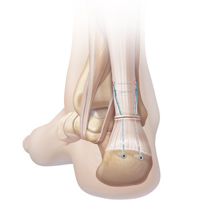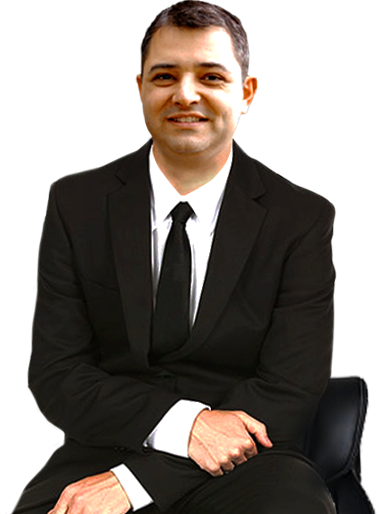Achilles Tendon Rupture – Percutaneous Repair
Achilles tendon rupture generally occurs with sudden forceful push-off and commonly during sports. It results in complete tearing of the tendon with some retraction of the tendon ends. Optimal treatment for this common injury has been extensively studied, yet it still remains somewhat controversial. What we do know, is that with appropriate treatment the tendon will heal without or with surgery. The main benefit of surgery is a reduced risk of re-rupture and probably greater push-off strength. Most athletically active patients choose to have surgical repair.
The Surgery

You will need to have a general anaesthetic and local anaesthetic. Antibiotics are administered intra- venously. You are positioned on the surgical table so as to allow access to the back of the ankle. At the site of the tear, a small (~5cm or smaller) incision is made and the tear is exposed. Care is taken to avoid injury to surrounding structures. Sutures are passed through the upper retracted tendon end and these are passed under the skin to the heel-bone (calcaneum), where they are secured with strong plastic anchors. The skin is closed and a cast is applied.
Post-Operatively
You will have your foot elevated on 1-2 pillows to reduce swelling. The local anaesthetic will provide you with pain relief, and will make your foot and toes temporarily numb. You will generally spend the night in hospital and you will be safe to ambulate with crutches, as soon as you feel comfortable. You will need to take medications for pain relief and for DVT prevention (injections or Aspirin). The cast and sutures are removed at 2 weeks and you will be placed into a CAM boot with heel wedges/raises. You will need to see a physiotherapist for rehabilitation, preferably on the same day. Below is an estimate of your recovery. See my rehabilitation protocol for more details.
- Type of Activity
- Time-frame
- Walking
- 2 weeks
- Driving (right ankle)
- 3 months
- Jogging
- 4-6 months
- Sport
- 6-12 months
- Activity
- Timeframe (approximate)
- No weight bearing in cast
- 0-2 wks
- Walking with boot with crutches
- 2wks - 10wks
- Physiotherapy
- 2wks -
- Full Recovery
- 6 -12 mts
Risks of surgery
All surgical procedures carry some risk. The risk of complications with Achilles rupture repair is low. Most patients benefit from surgery. A small number of patients can be made worse. You should weigh up the benefits with the risks prior to electing to have surgery.
This is a list of the most common problems which can/do occur:
- Infection – minimised with antibiotics, elevation, keeping the dressing clean and dry
- Nerve injury – resulting in numbness or pins and needles, occasionally pain
- Wound healing problems – increased if smoking, diabetes, poor circulation
- DVT – clot/s in the deep veins of the leg (increased if smoking, contraceptive pill, hormone replacement or previous DVT)
- Stiffness – reduced range of movement of the ankle joint
- Swelling – is normal and improves with time, but the tendon will usually be thicker than before it ruptured
- Bleeding – usually just visible through the dressing
- Pain – which may require strong medication (usually Paracetamol is adequate) These are quite rare complications, but they can and do happen:
- Re-rupture – this may or may not need a re-operation, most common in first 3 months
- PE – pulmonary embolus, or DVT clots that travel to the lung resulting in breathing problems/coughing
- Complex regional pain syndrome (CRPS) – nerve pain syndrome, risk reduced with Vitamin C 500mg daily for 40 days
- Anaesthetic complications – more likely if there are pre-existing medical disorders
Achilles Tendon Rehabilitation Protocol
You will need the Adobe Reader to view and print these documents.
![]()









